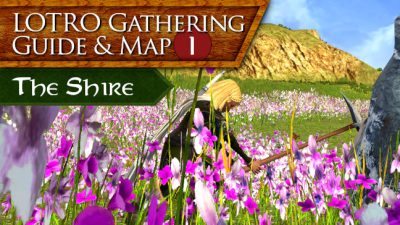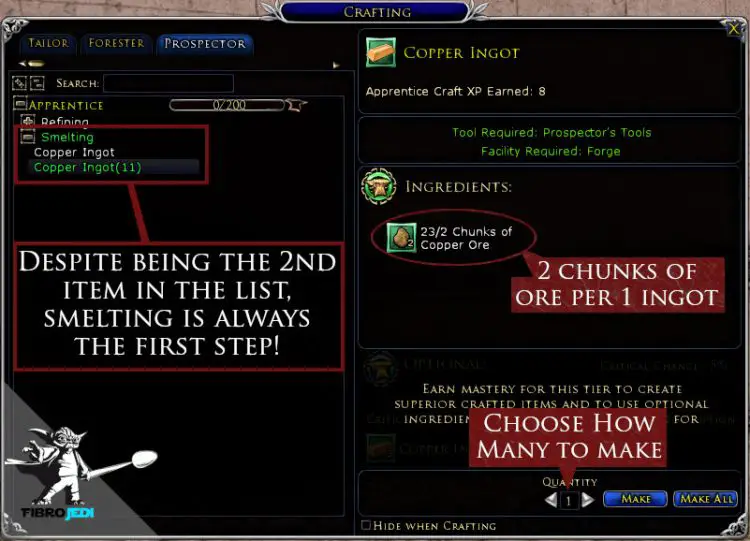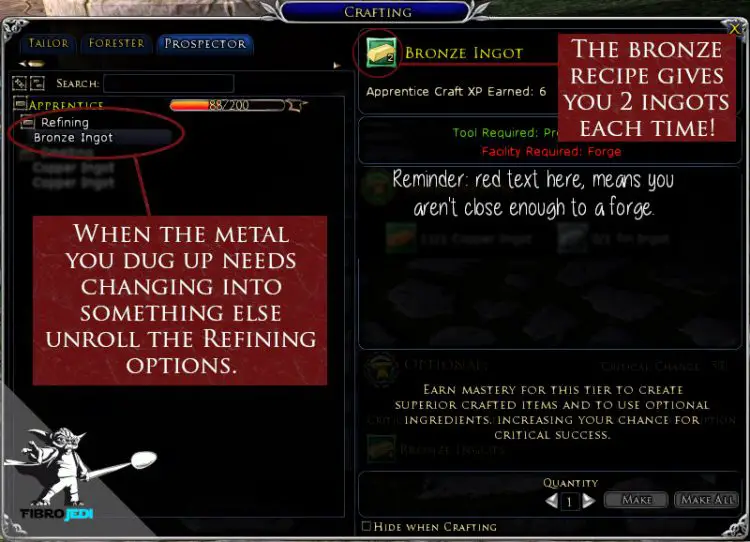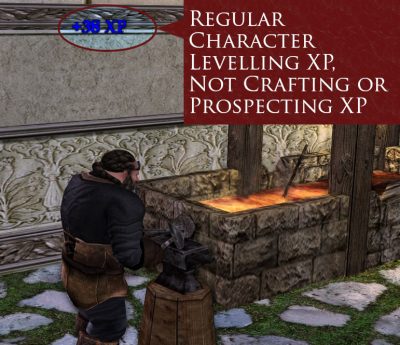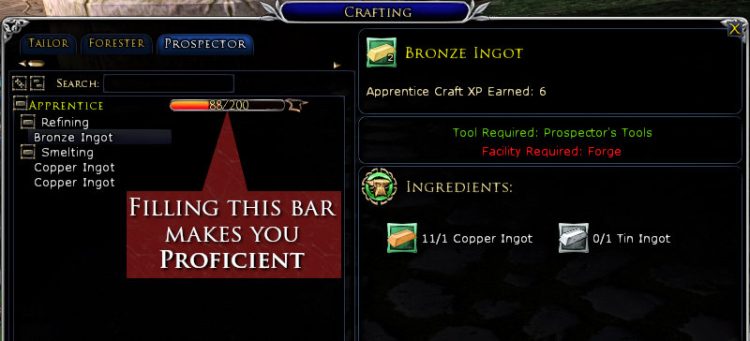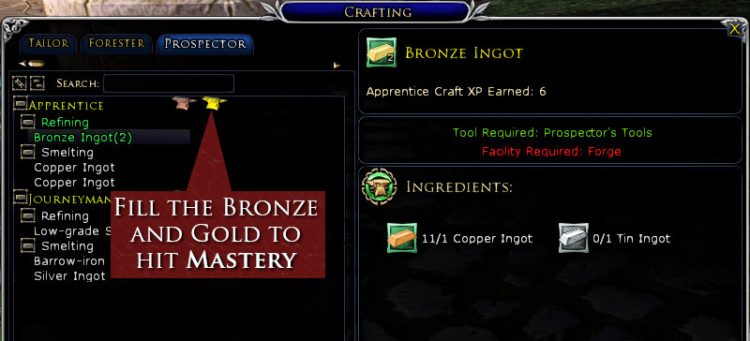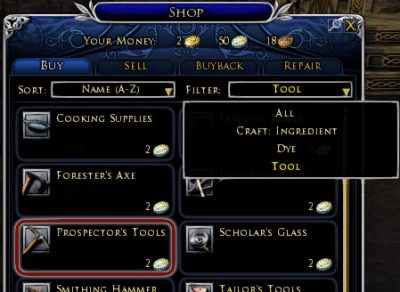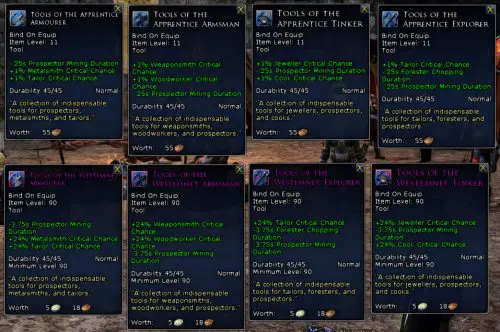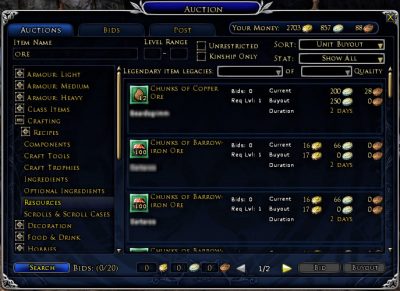
Post Sections ⇅
- What is Prospecting?
- How to Start the LOTRO Prospecting Profession
- From Ore to Ingots
- How to Level Prospecting Up
- Prospector Tiers
- Proficiency and Mastery
- Prospecting Tools
- Storing and Sharing Mined Materials
- Where to Mine for Early Metals
- 5 Reasons to Be a Prospector in LOTRO
The LOTRO Prospector profession makes a miner out of you. Travel the realms of Middle-earth in search of metals, gems and other items that can be used for crafting. In this guide to prospecting, I’ll take you through what it is, how to get started and the process of making those ingots. I’ll also touch on why you should add Prospector to at least one of your character’s professions.
Let’s get digging.
What is Prospecting?
Prospecting is Mining by another name. It’s going out and digging with a pickaxe to see what you can find that may be of value to you or others.
In LOTRO, prospector is both a gathering and “processing” profession. For while you are responsible for digging stuff up, it is also your job to turn them into useful ingots for “pure” crafting professions.
What Items Do You Get Through Mining?
The main types of items, or ingredients are:
- Metal Ores, later known as Skarn
- Uncut stones and gems for Jewellers
- Dye-making ingredients for Scholars
- Critical Chance Items for Metalsmith (Heavy Armour), Jeweller and Weaponsmith.
How to Start the LOTRO Prospecting Profession
In summary:
- Ensure you have a crafting profession slot available, or are willing to drop one first.
- Visit a Mistress or Master of Apprentices to learn Prospecting.
- Equip a Prospector’s Pickaxe or other Multi-tool.
- Turn on “Track Mines”
- Explore Middle-Earth and dig up deposits on the landscape.
Let’s break that down!
1. Do You Have a Slot Free?
Before update 41, you could only have three crafting or gathering professions per character. These can be any combination of those available.
After update 41, you can unlock fourth crafting profession for LOTRO Points.
So, check whether you have a slot available, or if you’re willing to drop one of your existing professions and learn prospecting in its place.
2. Train in Prospecting

Visit a Mistress/Master of Apprentices![]() .
.
When you interact with them, you’ll be either allowed to simply “train” your skill, or you will need to choose
a profession to drop before you can learn mining.
3. Complete the Tutorial
Assuming your character has never done it before, complete the tutorial. It contributes towards fun title deeds like Easily Lost![]() , Handyman, Student of Metalwork and Apprentice of Blades.
, Handyman, Student of Metalwork and Apprentice of Blades.
You will already have been given your first, basic, fragile pickaxe. Don’t let that bother you just yet. Right click it to equip it so you can complete the tutorial.
You pick up the quest from the Mistress/Master of Apprentices, but they will refer you to the right NPC to continue it. This will differ depending on where you complete the tutorial.
4. Turn on “Track Mines”

Track Mines is a toggle skill that enables your Minimap to detect nearby metal deposits.
When one is within range, a blue arrow appears on your Minimap/radar, so you can walk towards it.
Once you’re right on it, a green icon appears on the minimap. Though, by that point, you can actually see the thing!
5. Explore and Dig
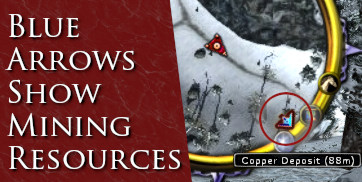
That’s it. Sort of. You can now wander Middle-Earth in search of riches. Or metal, at least.
While you can track nearby gathering node, LOTRO does not yet have a skill that let’s you know in which direction to wander. So, unless you only want to go gathering, pick up the metals as you do questing. Basically, keep ![]() Track Mines on if you will need ore from the area you’re in!
Track Mines on if you will need ore from the area you’re in!
Just bear in mind, you will need to make sure your character’s level and gear is at or above the nearby enemies. That way you can deal with pests while gathering.
6. Where to Wander First
As an apprentice Prospector, you’re looking for Copper Deposits. These can be found in:
- The Shire (See: Where to mine Copper in the Shire)
- Ered Luin
- Eastern Bree-land
- Swanfleet (part of Before the Shadow)
From Ore to Ingots
Of course, while you might go digging for pleasure and relaxation (and those are perfectly alright reasons to do it), that’s not all it’s useful for.
The primary function of Prospecting is to provide materials for other crafting professions. Some of these (such as raw gemstones and dye ingredients) can be passed over as you find them. When dealing with metal, however, you need to turn the ore into usable ingots first.
How to Make Ingots
In this sense, and pretty much only this sense, a Prospector is also a crafter. That’s why I call it a “processing” profession. Neither the Forester Profession nor Prospector are included in ![]() Crafting XP bonus days in the LOTRO Events Schedule. I’m not sure that makes sense, but it’s always been that way.
Crafting XP bonus days in the LOTRO Events Schedule. I’m not sure that makes sense, but it’s always been that way.
1. Gather Ore

As already mentioned, you’ll need to mine for ore. Each node (a term for any spot on a map with something you can collect on it), contains 1-3 ore, usually. If you find a Rich or Bountiful node then that may have 4 or 5 Ore, or it may have multiple other items in it too.
Remember to turn on ![]() Track Mines
Track Mines
Get out there and collect loads of ![]() Copper Ore. Enjoy the process, explore Middle-Earth as you’re led by the Blue Arrows.
Copper Ore. Enjoy the process, explore Middle-Earth as you’re led by the Blue Arrows.
2. Find a Forge

Visit a crafting area (towns, settlements, housing areas) and use a Forge.
If you’re new to LOTRO, maps can be confusing when it comes to crafting. All crafting facilities are marked with gold forges. But they’re unlikely to all be forges (in some places there might not even be one!). But if you hover over the icon, the tooltip will tell you which crafting facility it is.
Once you interact with a Forge, it will bring up the crafting panel allowing you to get started on making ingots.
3. Make Ingots
Hit the Prospector tab, and look under “Apprentice” (or whichever tier you’re on), and turn those ores into ingots.
You can choose to make one, a few or all of your ingots. This may seem odd at first – because Copper Ore can only be used to make Copper Ingots. But it won’t be long before different ores can become other metals.
Press the appropriate button and your character will get to work with that hammer.
4. Refining
You will notice under “Apprentice” that you have a “Refining” header. Refining is the process of taking your basic metal and changing it somehow. Copper is a great example, really. As copper, Jewellers can make rings, necklaces and earrings. But no one ever heard of copper armour, right? But bronze armour is more plausible.
Turning copper to bronze is refining.
Note: check what item is ultimately being created from your ingots before refining the metals. Once refined, the process cannot be reversed!
How Do I Make Bronze Ingots? Where Do I Dig For Tin Ingots?
Periodically, you’ll find a returning player ask this question in World Chat: “Where can I dig up tin?”.
Now, personally, I’ve never had to dig up tin, but I’ve been around for less than half of LOTRO’s lifetime. Apparently there was a time when you had to. Making Bronze does, in fact, need tin. But you do not mine for it!
To make Bronze Ingots you need to:
- Make Copper Ingots
- Buy some Tin Ingots from a Supplier NPC
- Use a Forge and look under “Refining”. Combine your crafted Copper Ingots and purchased Tin Ingots, and then you can make Bronze Ingots.
How to Level Prospecting Up
Crafting XP (CXP)
You level your Prospector profession in the crafting part of the flow. Making ingots and/or refining them into other materials. In short, you earn your CXP at the Forge, not in the Field.
This means, as a Prospector, you don’t get ![]() Craft XP (CXP) from the Mining. Yep, no CXP from the prospecting part! Compared to other MMOs, this may be a little counter-intuitive.
Craft XP (CXP) from the Mining. Yep, no CXP from the prospecting part! Compared to other MMOs, this may be a little counter-intuitive.
Both the initial crafting of ingots from ore and the refining grant Crafting XP, but at different rates. For Copper/Bronze:
- Smelting: 8 × Apprentice Prospector Crafting XP/item
- Refining: 6 × Apprentice Prospector Crafting XP/item
Hard Tack Event
When it is active, the LOTRO Hard Tack Event is a way to get more Prospector XP. This is achieved through the (shock!) prospecting part of the quests.
–>
Regular XP
You do get a little regular XP once you’ve gathered from a node. You also receive a small amount for each item you create.
Prospector Tiers
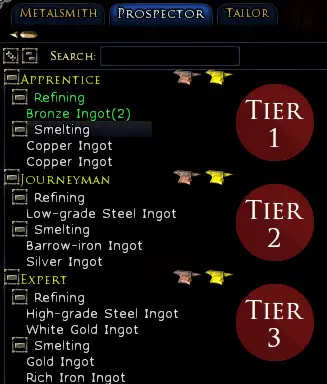
As with other crafting and gathering professions there are tiers. e.g. Apprentice (T1), Journeyman (T2), Expert (T3) and so on. Once you earn a certain amount of CXP in one tier, it will unlock the next one automatically.
This is important as you cannot mine from higher tier deposits unless you have unlocked that tier.
For Example
You cannot mine Barrow-Iron in any region until you have unlocked the Journeyman prospecting tier. So get digging up all the copper nodes you can find and turn them into ingots!
How Gathering Tiers Match Crafting Tiers
They exactly match. Apprentice-level materials match Apprentice-level crafting.
In other games you may have overlap between levels, but LOTRO makes this much more obvious.
Another point is that you cannot earn CXP for a tier by crafting from another tier.
Proficiency and Mastery
Once you have filled your bronze (brown) bar with enough CXP, you are proficient. The bronze bar becomes a bronze anvil to show you’ve done that bit.
What Does Proficiency Mean?
Being Proficient gives you the following:
- A relevant title: e.g. Apprentice Prospector
- When processing ores, you have a chance of a “critical hit”. When you “crit” a craft you make more ingots for the same amount of raw materials. Admittedly, the base rate is 5% but as you process more and more materials, you will notice it.
- You unlock the next tier of crafting (until you reach endgame, before a new tier is released!)
- You can work towards Mastery of the current tier.
What Does Mastery Mean?
Build even more CXP and you can fill the gold bar to achieve Mastery. This gives you the following:
- A relevant title: e.g. Master Apprentice Prospector (yep, a “Master Apprentice”)
- Ability to hit Mastery on the Next Tier: In order to be able to achieve Mastery on a tier, you have to have completed it on the previous tier. Except Apprentice-level as there is no previous tier!
Prospecting Tools
There are various tools you can use as a Prospector which means multiple ways to obtain them. A pickaxe is not just a pickaxe my friend, oh no!
Free First Tool

When you initially train as a Prospector, you are given an Inferior Prospectors Tools item.
This is functional but, unless you’re VIP, it will wear out and often need mending. That can be annoying if you’re gathering a long way from a settlement.
LOTRO Prospector Profession Guide
Very Cheap Second Tool
If you have no other tools on-hand, immediately swap your inferior tool for Prospector’s Tools from a Supplier NPC. It only costs ![]() ×2 Silver.
×2 Silver.
It has greater durability, so wears out much slower than the first one. If you’re a VIP, you can ignore me on this point!
Crafted Toolkits
Despite the removal of the groupings of crafting professions, there are still Metalsmith recipes that create “multi-tools”. These aren’t quite as all-encompassing as Universal Toolkits, but they do give functionality and bonuses to three crafting/gathering professions at once.
There are also strong versions of these tools in the Metalsmith’s Guild. Find out more about Crafting Guilds here.
Universal Toolkits
The LOTRO Store (and sometimes certain packages for expansions) offers Universal Toolkits. These do what they say – you equip it and you can use it for all crafting and gathering professions without swapping tools.
There is also an “enduring” one. What are the differences between the Universal and the Enduring toolkits?
- 100 Durability (45 on the non-enduring): for any non-VIPs who want the best durability on their toolkits.
- Reduced Gathering Time: 4.5 seconds less, as opposed to 3 seconds less. For those to whom 1.5 seconds makes a huge difference in their lives.
The Hard Tack Event

The Hard Tack at Thorin’s Hall Event gives you the option to build your own Prospector’s Pickaxe with one of a few designs.
As you improve your pick, its stats improve: reduced mining time, increased critical prospector crafting and an increased chance of finding rare items.
The Event is scheduled for its first run on the 1st August 2024, the day after Update 41![]() lands, so hopefully we can get started on our pickaxes sooner rather than later.
lands, so hopefully we can get started on our pickaxes sooner rather than later.
Storing and Sharing Mined Materials
I don’t want to duplicate what I’ve said elsewhere, but sometimes a summary in-context can still be helpful.
Going mining is great and, for a while having those materials in your bags is fine. But it doesn’t take long before you need to keep them anywhere else! Where you store them depends completely on who (or which of your characters) need them.
For The Prospector Character
There are many different types of storage, but three primary ones if you only need one character to use the prospecting materials.
- 1. In Your Bags:
If you have a lot of bag space, anyway. You can move slots between windows, meaning you can create a “crafting” bag. Adding extra bag space for LOTRO Points is the cheapest way per slot.
LOTRO Points is the cheapest way per slot. - 2. Crafting Carry-alls:
Only take up one inventory slot but can store up to 50 stacks of items, depending on carry-all size. The price/slot varies wildly. See: Are Carry-alls worth it? - 3. Vault:
Unless you have quick Milestone/Return-To cooldowns (or happen to be a Warden/Hunter/Mariner) having to get back to a town may be annoying. VIPs bypass this annoyance with the in-the-field Town Services tool .
.
For You and Others
Very often crafting materials are needed among other characters. And, if you play with friends, or in a Kinship, you may want to help another player out.
- 4. Housing/Shared Storage
You have two types of Shared Storage: the one at the Vault-keepers (no free slots) and those in your house (some free slots with any type of house). All your characters can add and remove crafting materials from them. They’re fairly convenient if you don’t mind going to collect the stored, dug-up materials. But they can be pricey to expand. - 5. Kin Chest
If you’re in a Kin, others may need your old (or current) materials. Check with your Kin leader if there are in-house rules on taking materials out. But you can store stuff for you and others this way.
Where to Mine for Early Metals
Just as a kick-starter, here are some zones for you when you are looking for early-tier prospecting modes.
Copper
- (Eastern) Bree-land
- Ered Luin
- The Shire
- Swanfleet
Barrow-Iron/Silver
- Cardolan
- (Western) Bree-land
- (Western) Lone-land
- (Western) North Downs
- (North-East of) The Shire
Rich Iron/Gold
- (Eastern) Lone-lands
- (Eastern) North Downs
- (Southern) Evendim
Dwarf Iron/Platinum
- (South-eastern) Lone-lands
- The Trollshaws
- Dol Dinen in the North Downs
5 Reasons to Be a Prospector in LOTRO
After all that, what are my top reasons you should consider taking up prospecting?
- Gather Crafting Materials for Yourself:
You don’t need to depend on others, or on Auction House prices when improving your gearing. - Add Prospecting to a Forester Character:
make your gathering more efficient and create a “pure gatherer”. Have Prospector, Forester, Scholar and Farmer once you add a fourth profession, anyway! - Acquire Items for Other Players:
Keep your eye on World Chat, as often people ask if others have spare materials. Show the community spirit and help them out. - Sell Materials:
or sell the materials on the Auction House (AH). I found people offering low-level materials for gold and silver on AH, so you could join them. - Enjoy Middle-earth with minimal combat:
spending time gathering materials as a prospector (and Forester, for that matter) is a relaxed way to have time in LOTRO. Take in some sights and enjoy the environments and landscapes SSG have created for you.
Buying/Selling at the Auction House
As you can see above (or to the left on larger screens), people (not me) do sell low-level materials on the Auction House. So it is a valid reason to be a Prospector.
Even if you do not dig up loads to sell, anything you do not need could be sold.
Do be careful not to overpay. The Barrow-Iron Ore here equates to iver 160 silver per chunk! Once the fourth crafting profession is enabled, I would expect prices of low-level materials to skyrocket for a time. So be cautious if that’s how you want to level your prospector gathering.
TL;DR Pick Up Prospecting in LOTRO and Go Dig!
Being a Prospector opens up the way for you to gear yourself, especially in metal armour, certain weapons and jewellery slots. Getting started is really easy and gives you a chilled way to experience life in LOTRO.
Benefit your own character or bless others with the extras you have. Maybe sell some on the Auction house for extra silver. With four crafting/gathering professions possible from Update 41, now really is a good time to add it to your skillset!
And don’t forget, you can build your own pickaxe at the new Hard Tack event. Who knows, you might even get off your horse to mine. Miracles can happen, after all.

